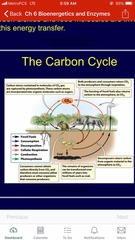![]()
![]()
![]()
Use LEFT and RIGHT arrow keys to navigate between flashcards;
Use UP and DOWN arrow keys to flip the card;
H to show hint;
A reads text to speech;
9 Cards in this Set
- Front
- Back
|
Metabolism |
-Sum of all chemical reactions in body -Transfers energy, follows laws of thermodynamics |
|
|
Laws of thermodynamics |
-1st: energy can’t be created/destroyed, only transformed -2nd: when reactions occurs, they become more disordered |
|
|
The carbon cycle |
-Sun is source of most energy -Light energy: used by producers, synthesize sugar -Non photosynthesizing: energy from food -carbon dioxide and food in energy transfer |
|
|
Carbon cycle |

Back (Definition) |
|
|
Transfer of electrons |
-Energy transfer needs transfer of electrons -Redox reaction: transfers electrons -Oxidation:loss of electrons -Reduction: gain of electrons |
|
|
Metabolism types |
-Anabolic: Biosynthetic, creates complex molecules out of smaller one -Catabolic: Breaks down complex molecules to get energy |
|
|
Enzymes |
-Speed up reactions -Biological catalysts •Lower activation energy •Increase reaction speed |
|
|
Enzyme structure |
-3D shape defines function -Active site: region where substrate binds •Induced fit: Active site mold around substrate |
|
|
Enzyme functions |
-Depends on random collisions -Multiple enzymes can be close, maximizes molecular collisions |

